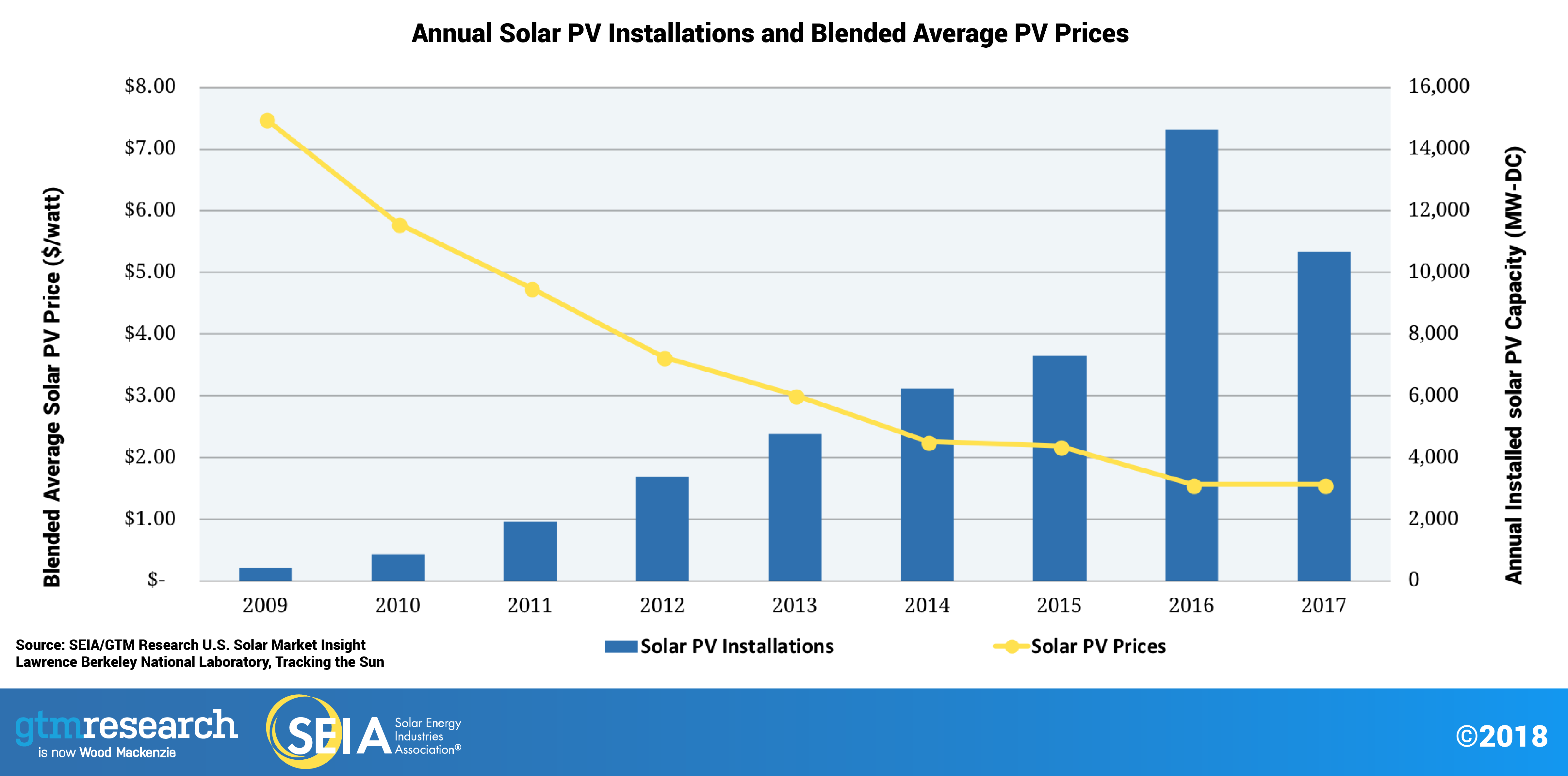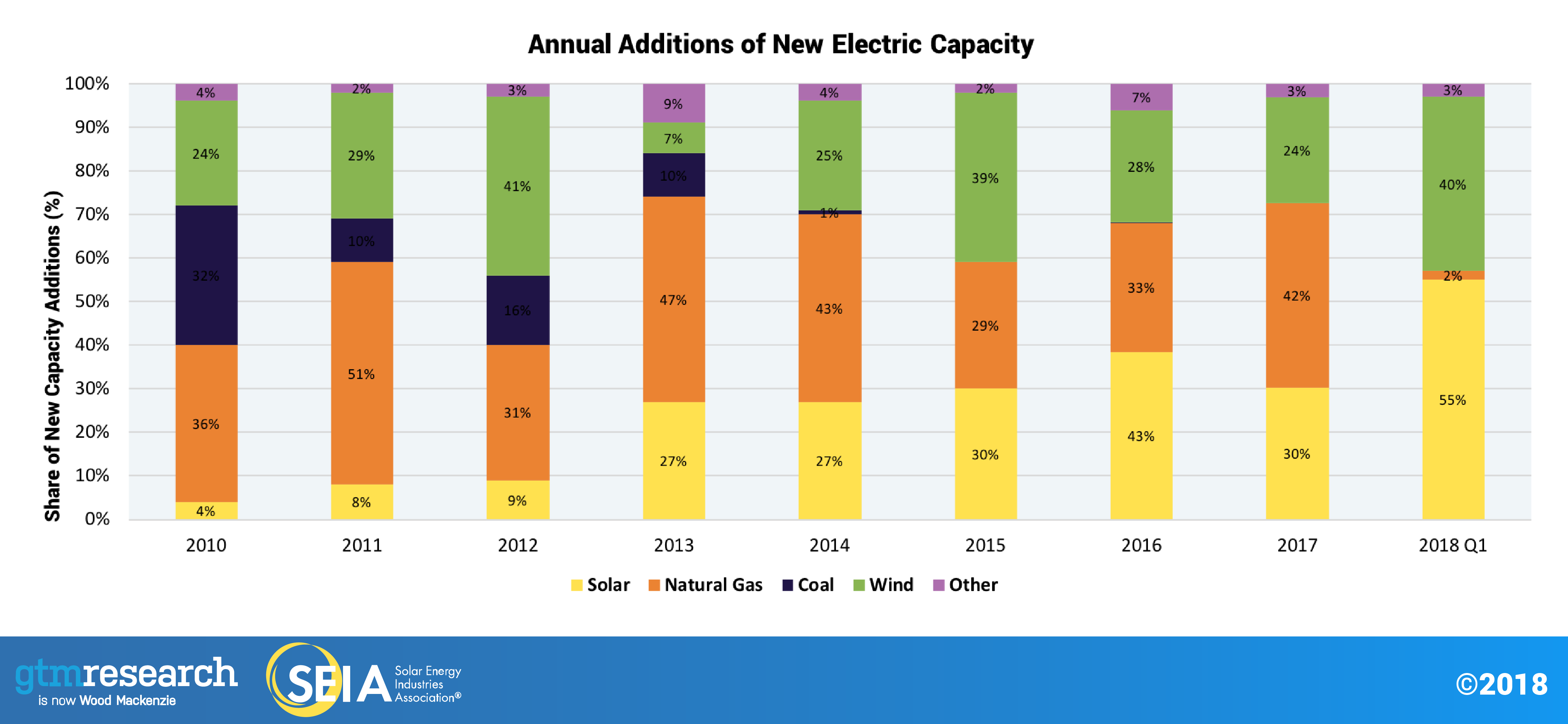Solar power is here right now. Georgia is #10 in the nation (up from #22 in 2017) by solar deployed (1,552.98 MW) and #7 in projected growth, according to the Solar Energy Industries Association (SEIA). That’s ahead of Florida, but still behind much farther north New Jersey and Massachusetts, which have less sun.

Graph: Top 10 Solar Power States, SEIA, Paul Horn, Inside Climate News
This Georgia solar improvement is despite Southern Company and Georgia Power cutting back on renewable energy investment last year and a hostile federal administration.

Graph: Georgia’s Solar Boom, SEIA and Paul Horn, InsideClimateNews
Sheer economies of scale continue decreasing solar prices and driving more solar installations, with more jobs.
The only other power source with prices dropping anywhere near that fast is wind.

Historical averaage levelized cost of electricty, 2009-2017; data Lazard estimates; graph Paul Horn, InsideClimate News
And there’s a lot more wind off the Georgia coast than Georgia Power would want you to believe. Jennette Gayer, Environment Georgia, Press Release, 28 March 2018, Offshore wind cOffshore Winds Enough to Power Georgia,
Winds blowing off the Georgia coast could provide enough electricity each year to power the state at current energy use levels, according to a report released today by Environment Georgia. If Georgia converted all activities currently powered by gasoline, natural gas and other fossil fuels (like transportation and home heating) to electricity, the energy provided by offshore wind turbines could still produce 70 percent of the power needed to run the entire state.
Solar power could supply the rest, especially with batteries.
“We’re facing rising seas, intensifying storms, and old and new health threats — because we’ve relied so long on dirty energy sources,” said Jennette Gayer, of Environment Georgia. “But sitting right here next to us is the Atlantic Coast, and it’s a massive source of totally clean power. Let’s just say ‘thank you, Mother Nature,’ and do what we should have done in the first place — harness the wind.”
While offshore wind is a proven technology overseas, it has been slow to take off in the United States. To date, only one wind farm is operating in the U.S., off the coast of Rhode Island. Meanwhile, Europe hosts 4,100 offshore wind turbines that supply enough electricity to power more than 20 million homes each day. But more American offshore wind is on the horizon: There are now 13 leased offshore wind projects moving forward in the U.S., which could provide enough electricity to power approximately 5.2 million homes.
“U.S. deployment of offshore wind is no longer out of reach — it is a reality that continues to gain momentum all along the Atlantic Coast,” said Mary Hallisey the Senior Director of Planning and Operations with Georgia Tech’s Strategic Energy Institute. “Coastal waters along the southeastern states hold great potential for offshore wind and we should take advantage of the opportunity to move forward with this clean energy option.”…
“This is not your father’s offshore wind,” said Gayer. “With improved technology and declining costs, harnessing the abundant, pollution-free energy off our coasts makes more sense than ever.”
So far as I know, Georgia Power is still “studying” offshore wind. The Environment Georgia study indicates the time for just studying is over.
For solar power, there is for sure no need for further study. We got to #10 due to concerted pressure by Sierra Club, Environment Georgia, WWALS, and many others. It’s time for GWC to join in and help Georgia get on with sun and wind power to shut down all fossil fuel and nuclear plants.
James Bruggers, InsideClimateNews, 14 June 2018, How Georgia Became a Top 10 Solar State, With Lawmakers Barely Lifting a Finger: The state has plenty of sun, but little support for solar power in the legislature. Here’s how a Republican who goes by ‘Bubba’ changed the energy landscape.
Dithering is already costing us jobs, industry, and money. Robynne Boyd, NRDC, 8 May 2017, Offshore Wind: A Southern Thing? The Southeast has the hospitable weather and the shallow waters—but does it have the will?
In the end, it may be jealousy that causes the South to take the plunge. If the Northeast becomes a mecca for offshore wind, the economic benefits will be worthy of envy. But by then, there’s a risk that the South may have missed the boat. For while small components of the supply chain will pop up anywhere offshore wind develops, the strongest links—the manufacturing of large components (nacelles, towers, and blades), which are transportable only by water—will go where the majority of wind farms are, in Yankee territory.
And we’ve already seen this happen elsewhere. Reporter, EnergyVoice, Aberdeen Journals Limited, 25 June 2018, Blow to Wick harbour over Moray East windfarm,
Wick harbour bosses have been dealt a blow after Fraserburgh was chosen to become the operations and maintenance base of Moray Offshore Renewables Ltd (MORL).
They had been in the running, along with Buckie, to service the massive new wind farm being developed in the Outer Moray Firth.
Willie Watt, chairman of Wick Harbour Authority, said: “It’s disappointing news for Wick and Caithness but MORL changed their strategy for the operations, management and maintenance of their wind farm and we just couldn’t compete for that. If we had the big quay which we’re planning to develop, we would have been in pole position to win the work.”
What did Wick (upper center in the map) in Caithness lose to Fraserburgh (lower right in the map) much farther away in Aberdeenshire?

Map:
Moray East: The Project, by Moray Offshore.
David Proctor, Energy Voice, Aberdeen Journals Limited, 19 June 2018, Fraserburgh Harbour set for boost with wind farm project,
A north-east town is in line for a boost after becoming the front runner for a lucrative wind farm project.
Fraserburgh Harbour is the favourite to land the contract for a new maintenance centre connected to the Moray East Offshore Windfarm.
The centre will play a crucial part in the multi-million pound project, to build nearly 100 turbines in the Moray Firth.
The deal — which will create dozens of jobs and allow NesCol to provide specialist training — was last night hailed as a vote of confidence in the facilities at Fraserburgh Harbour.
Unlike sparsely populated and remote Caithness (the most northerly county on the mainland of Britain), Georgia has plenty of port and other facilities on its coast. So it’s pure lack of political will that is leaving Georgia and the southeast behind the U.S. northeast in wind power.
Solar and wind power continue to dominate new electric power deployments. Georgia and Florida can either get on board or be left behind.
-jsq
Investigative reporting costs money, for open records requests, copying, web hosting, gasoline, and cameras, and with sufficient funds we can pay students to do further research. You can donate to LAKE today!
Short Link:

